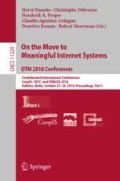Abstract
Extracting constraints and process models from natural language text is an ongoing challenge. While the focus of current research is merely on the extraction itself, this paper presents a three step approach to group constraints as well as to detect and display relations between constraints in order to ease their implementation. For this, the approach uses NLP techniques to extract sentences containing constraints, group them by, e.g., stakeholders or topics, and detect redundant, subsuming, and conflicting pairs of constraints. These relations are displayed using network maps. The approach is prototypically implemented and evaluated based on regulatory documents from the financial sector as well as expert interviews.
Access this chapter
Tax calculation will be finalised at checkout
Purchases are for personal use only
Notes
- 1.
The POS tags are necessary at a later stage of the method.
- 2.
The quality of the outcome of this step relies on the NLP framework that is used.
- 3.
- 4.
- 5.
- 6.
- 7.
Another possibility is to use a glossary and carry out the grouping based on the therein contained terms.
References
Aggarwal, C.C., Zhai, C.: Mining Text Data. Springer, New York (2012). https://doi.org/10.1007/978-1-4614-3223-4
Al Omran, F.N.A., Treude, C.: Choosing an NLP library for analyzing software documentation: a systematic literature review and a series of experiments. In: Proceedings of the 14th International Conference on Mining Software Repositories, pp. 187–197. IEEE Press (2017)
de AR Goncalves, J.C., Santoro, F.M., Baiao, F.A.: Business process mining from group stories. In: 13th International Conference on Computer Supported Cooperative Work in Design, CSCWD 2009, pp. 161–166. IEEE (2009)
Arthur, D., Vassilvitskii, S.: k-means++: the advantages of careful seeding. In: Proceedings of the Eighteenth Annual ACM-SIAM Symposium on Discrete Algorithms, pp. 1027–1035. Society for Industrial and Applied Mathematics (2007)
Bajwa, I.S., Lee, M.G., Bordbar, B.: SBVR business rules generation from natural language specification. In: AAAI Spring Symposium: AI for Business Agility, pp. 2–8 (2011)
Bird, S., Klein, E., Loper, E.: Natural Language Processing with Python: Analyzing Text with the Natural Language Toolkit. O’Reilly Media, Inc., Sebastopol (2009)
Deeptimahanti, D.K., Babar, M.A.: An automated tool for generating UML models from natural language requirements. In: Proceedings of the 2009 IEEE/ACM International Conference on Automated Software Engineering, pp. 680–682. IEEE Computer Society (2009)
Dijkman, R., Dumas, M., Van Dongen, B., Käärik, R., Mendling, J.: Similarity of business process models: metrics and evaluation. Inf. Syst. 36(2), 498–516 (2011)
Dragoni, M., Villata, S., Rizzi, W., Governatori, G.: Combining NLP approaches for rule extraction from legal documents. In: 1st Workshop on MIning and REasoning with Legal texts (MIREL 2016) (2016)
Friedrich, F., Mendling, J., Puhlmann, F.: Process model generation from natural language text. In: Mouratidis, H., Rolland, C. (eds.) CAiSE 2011. LNCS, vol. 6741, pp. 482–496. Springer, Heidelberg (2011). https://doi.org/10.1007/978-3-642-21640-4_36
Ghose, A., Koliadis, G., Chueng, A.: Process discovery from model and text artefacts. In: 2007 IEEE Congress on Services, pp. 167–174. IEEE (2007)
Hagberg, A., Swart, P., Schult, D.: Exploring network structure, dynamics, and function using networkx. Technical report, Los Alamos National Laboratory (LANL), Los Alamos, NM (United States) (2008)
Harabagiu, S., Hickl, A., Lacatusu, F.: Negation, contrast and contradiction in text processing. In: AAAI, vol. 6, pp. 755–762 (2006)
Hashmi, M., Governatori, G., Lam, H.P., Wynn, M.T.: Are we done with business process compliance: state of the art and challenges ahead. Knowl. Inf. Syst. 57, 1–55 (2018)
de Marneffe, M.C., Rafferty, A.R., Manning, C.D.: Identifying conflicting information in texts. In: Handbook of Natural Language Processing and Machine Translation: DARPA Global Autonomous Language Exploitation (2011)
Mikolov, T., Yih, W.T., Zweig, G.: Linguistic regularities in continuous space word representations. In: Proceedings of the 2013 Conference of the North American Chapter of the Association for Computational Linguistics: Human Language Technologies, pp. 746–751 (2013)
Miller, G.A., Beckwith, R., Fellbaum, C., Gross, D., Miller, K.J.: Introduction to wordnet: an on-line lexical database. Int. J. Lexicogr. 3(4), 235–244 (1990)
More, P., Phalnikar, R.: Generating UML diagrams from natural language specifications. Int. J. Appl. Inf. Syst. 1(8), 19–23 (2012)
Nguyen, T.A., Perkins, W.A., Laffey, T.J., Pecora, D.: Checking an expert systems knowledge base for consistency and completeness. In: IJCAI, vol. 85, pp. 375–378 (1985)
Pedregosa, F., et al.: Scikit-learn: machine learning in python. J. Mach. Learn. Res. 12(Oct), 2825–2830 (2011)
Pennington, J., Socher, R., Manning, C.: Glove: global vectors for word representation. In: Proceedings of the 2014 Conference on Empirical Methods in Natural Language Processing (EMNLP), pp. 1532–1543 (2014)
Riefer, M., Ternis, S.F., Thaler, T.: Mining process models from natural language text: a state-of-the-art analysis. In: Multikonferenz Wirtschaftsinformatik (MKWI 2016), pp. 9–11, March 2016
Rinderle-Ma, S., Ma, Z., Madlmayr, B.: Using content analysis for privacy requirement extraction and policy formalization. In: Enterprise Modelling and Information Systems Architectures, pp. 93–107 (2015)
Selway, M., Grossmann, G., Mayer, W., Stumptner, M.: Formalising natural language specifications using a cognitive linguistic/configuration based approach. Inf. Syst. 54, 191–208 (2015)
Sinha, A., Paradkar, A.: Use cases to process specifications in business process modeling notation. In: 2010 IEEE International Conference on Web Services (ICWS), pp. 473–480. IEEE (2010)
Winter, K., Rinderle-Ma, S., Grossmann, W., Feinerer, I., Ma, Z.: Characterizing regulatory documents and guidelines based on text mining. In: Panetto, H. (ed.) OTM 2017. LNCS, vol. 10573, pp. 3–20. Springer, Cham (2017). https://doi.org/10.1007/978-3-319-69462-7_1
Acknowledgment
This work has been funded by the Vienna Science and Technology Fund (WWTF) through project ICT15-072.
Author information
Authors and Affiliations
Corresponding author
Editor information
Editors and Affiliations
Rights and permissions
Copyright information
© 2018 Springer Nature Switzerland AG
About this paper
Cite this paper
Winter, K., Rinderle-Ma, S. (2018). Detecting Constraints and Their Relations from Regulatory Documents Using NLP Techniques. In: Panetto, H., Debruyne, C., Proper, H., Ardagna, C., Roman, D., Meersman, R. (eds) On the Move to Meaningful Internet Systems. OTM 2018 Conferences. OTM 2018. Lecture Notes in Computer Science(), vol 11229. Springer, Cham. https://doi.org/10.1007/978-3-030-02610-3_15
Download citation
DOI: https://doi.org/10.1007/978-3-030-02610-3_15
Published:
Publisher Name: Springer, Cham
Print ISBN: 978-3-030-02609-7
Online ISBN: 978-3-030-02610-3
eBook Packages: Computer ScienceComputer Science (R0)

